1 dead and 3 injured! A sudden flash fire occurred at a chemical company in Shanghai!
On March 24, 2025, a flash fire accident occurred during a pharmaceutical intermediate synthesis experiment conducted by laboratory personnel at a pharmaceutical technology company located in the Pudong New Area, resulting in 1 death and 3 injuries. The cause of the accident is currently under investigation.
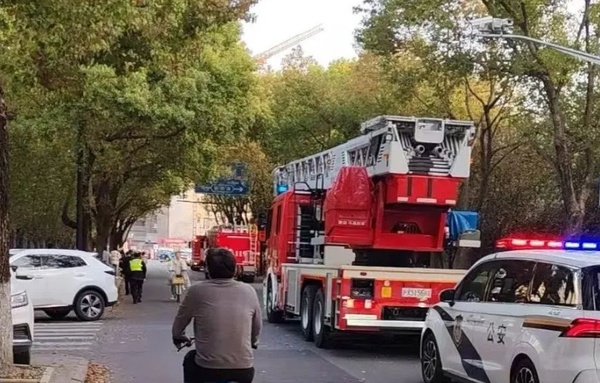
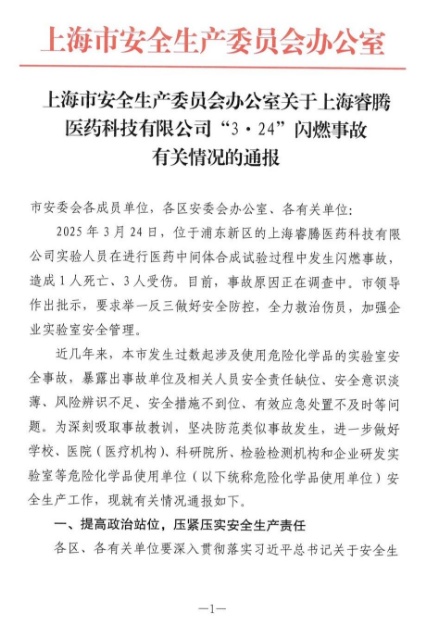
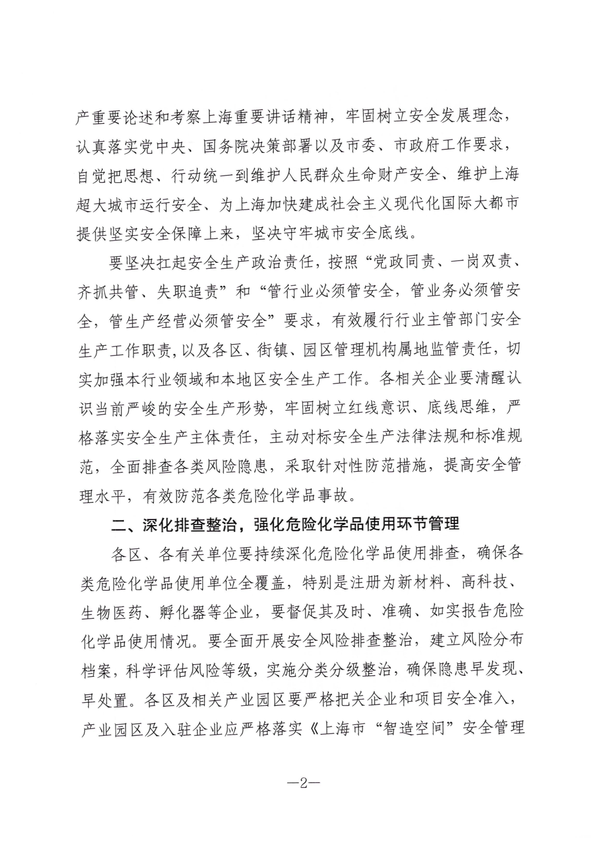
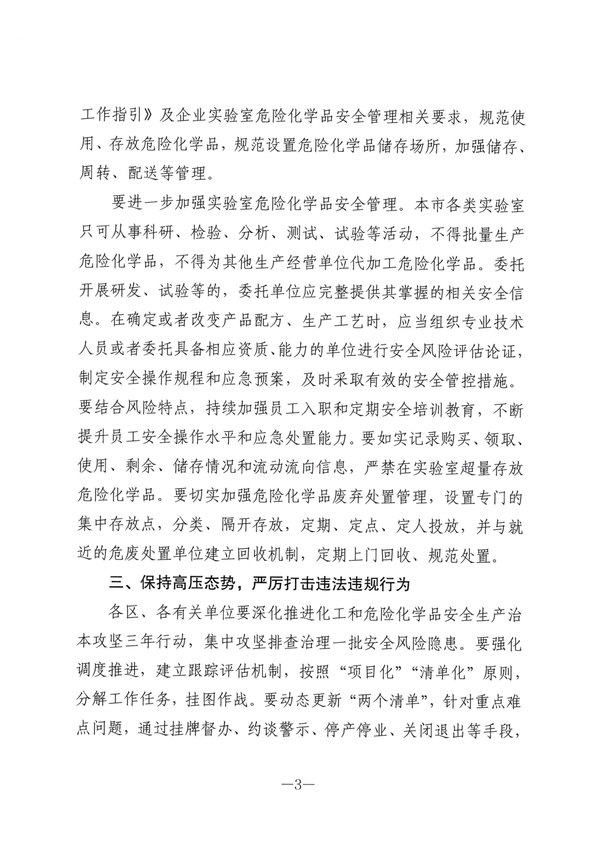
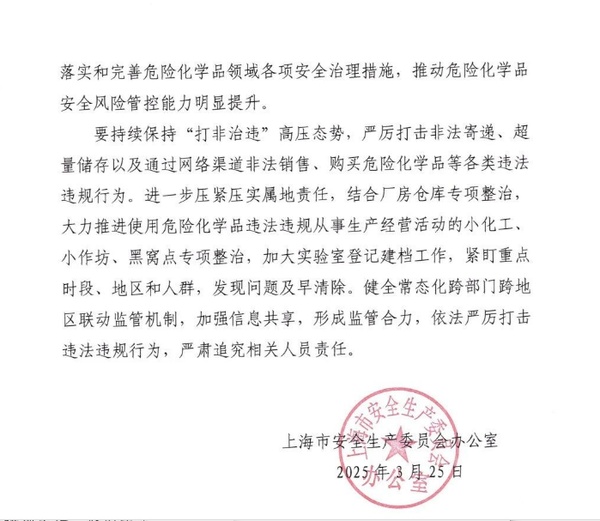
Involved enterprise
Shanghai Ruiteng Pharmaceutical Technology Co., Ltd. was established in 2016, formerly known as Shanghai Ruibo Chemical Co., Ltd. The company is committed to providing CMC solutions covering the entire process from preclinical research to commercial production for global pharmaceutical and biopharmaceutical companies. The company currently has over 100 employees, with its headquarters and R&D center located in the Zhangjiang Hi-Tech Park in Shanghai, and production bases in Jiangxi and Anhui.
The pharmaceutical and chemical industry has complex production equipment and processes with high inherent risks. The auxiliary systems are vast, and operational requirements are stringent. In recent years, accidents in the pharmaceutical and chemical industry have accounted for a significant portion of production safety incidents, drawing considerable attention to safety management in pharmaceutical companies.
According to statistics from the past decade, as much as 56% of factory accidents in chemical enterprises are caused by uncontrolled or near-uncontrolled reactions. This finding echoes the statistical analysis of batch chemical process accidents in Japan, which indicates that 51% to 58% of fire sources stem from reaction heat.
Similarly, a scholar in our country conducted a statistical analysis of production safety accidents in domestic pharmaceutical companies from 1999 to 2019. The results showed that explosion accidents in pharmaceutical companies are significant, accounting for 63% of the total number of production safety accidents and 91% of the fatalities caused by these accidents. From the development process of the accidents, it is often due to excessively high temperature and pressure in the reaction kettle or some violations during hot work that generate electrical sparks, leading to explosions in the reaction kettle.
The reasons related to people and organizations account for the largest proportion!
A domestic scholar analyzed the main causes of thermal safety accidents in China, France, and the UK. From 1984 to 2019, among the thermal runaway accidents in China, 55.9% were primarily attributed to human and organizational factors, 41.3% to physical and technical factors, and 2.8% to natural causes. Since 1988, in France, out of 43 thermal runaway accidents, 53.8% were due to human and organizational factors, 43.2% to physical and technical factors, and 3.1% to natural causes. In the UK, since 1988, 61.4% of thermal runaway accidents were attributed to human and organizational factors, while 38.6% were due to physical and technical factors. It can be seen that human and organizational factors account for the highest proportion of accident causes. Human and organizational factors include personnel operational errors, insufficient risk analysis, improper feed control, inadequate training, errors in reaction procedure settings, improper maintenance, and insufficient cleaning of reaction vessels.
The risks in the solvent recovery process should not be underestimated!
The solvent recovery process is a crucial step in the production of active pharmaceutical ingredients (APIs) because the manufacture of APIs belongs to the "solvent-using" industry, where operations such as adsorption, extraction, separation, and drying require a large amount of organic solvents. In API factories, solvent recovery is typically accompanied by processes such as concentration and distillation. The liquid being processed often contains flammable, explosive, and toxic hazardous chemical components, and the process involves heating, resulting in the evaporation of gaseous solvents. If the liquid is heated unevenly, it can lead to a rapid rise in temperature in certain areas; simultaneously, if the flow of solvent gas is obstructed or condensation is insufficient, there is a risk of increased gas pressure.
How to prevent and control risks in the production of fine chemicals?
First,
Conduct safety risk assessments for reactions and thermal stability tests for materials. It is crucial to pay close attention to the collection of core safety data related to hazardous processes, such as reaction temperature, decomposition temperature, adiabatic temperature rise, uncontrolled temperature, and maximum allowable pressure (set pressure for safety valves and rupture discs), to provide safety assurance for optimizing production processes and enhancing inherent safety levels. Conduct thermal stability tests on materials potentially involved in the reaction, including raw materials, intermediate products, products, and by-products, to clarify their initial decomposition temperature and the exothermic heat release during the decomposition process. Especially when impurities, metal ions, or unknown by-products may inadvertently mix into the reaction process due to improper control, the potential consequences should be evaluated and analyzed. For fine chemical production facilities involving nitration, chlorination, fluorination, diazotization, and peroxide processes, a comprehensive safety risk assessment of the entire production process should be conducted.
Second is
Production units involving hazardous chemical processes must achieve automated control and set up online monitoring facilities for temperature, pressure, stirring motor current, concentration detection instruments, pH meters, as well as pressure relief facilities and emergency cooling and emergency shutdown facilities as required. For nitration reactions, dual thermometers should be installed.
Three is
Implement automated control for material feeding and transfer to eliminate the possibility of errors caused by manual feeding. Enterprises should optimize the reaction process, adopting sequential control whenever possible to reduce the risk of operational mistakes in the sequence of feeding and discharging materials.
Four is
Ensure that the reaction kettle operates within the control limits specified in the process operating procedures, promptly address process alarms, and prevent the risk of uncontrolled reactions leading to material spraying and explosion accidents. For hazardous processes such as nitration, peroxide reactions, and diazotization, flow-limiting measures should be implemented to control the feeding speed. In nitration reactions, the feeding of nitrating agents should utilize double block valves.
Five is
Implement closed operations to avoid open work. For material feeding and discharging operations, as well as centrifugation operations that pose a risk of explosion, adopt safety operation methods that isolate air, such as inert gas replacement and protection.
Six is
Strictly implement the requirements of the "Guidelines for the Safe Handling of Abnormal Conditions in Chemical Production Processes (Trial)", and for fine chemical enterprises, follow the "Key Points for the Safe Handling of Typical Abnormal Conditions in Fine Chemical Enterprises". When a reactor malfunctions and stops, or when there is a sudden increase in temperature or pressure, or phenomena such as material boiling or material spillage indicate a loss of control in the reaction, the feed valve should be closed, heating should be stopped, and for exothermic reactions, the cooling system should be activated immediately. If the cooling system or stirring fails, the materials should be dispersed and transferred to other normally operating reactors. If control is still not achievable and materials need to be discharged, they should be released into a pre-prepared discharge facility that has been treated with quenching agents, and on-site discharge is strictly prohibited.
Seven is
During the continuous low-temperature charging of the reactor or before starting up with materials, a risk assessment should be conducted, and a reaction control operational plan and emergency response measures should be developed. For those with a risk of reaction loss of control, materials should be removed before starting up.
【Copyright and Disclaimer】The above information is collected and organized by PlastMatch. The copyright belongs to the original author. This article is reprinted for the purpose of providing more information, and it does not imply that PlastMatch endorses the views expressed in the article or guarantees its accuracy. If there are any errors in the source attribution or if your legitimate rights have been infringed, please contact us, and we will promptly correct or remove the content. If other media, websites, or individuals use the aforementioned content, they must clearly indicate the original source and origin of the work and assume legal responsibility on their own.
Most Popular
-

List Released! Mexico Announces 50% Tariff On 1,371 China Product Categories
-

Nissan Cuts Production of New Leaf EV in Half Due to Battery Shortage
-

New Breakthrough in Domestic Adiponitrile! Observing the Rise of China's Nylon Industry Chain from Tianchen Qixiang's Production
-

Dow, Wanhua, Huntsman Intensively Raise Prices! Who Controls the Global MDI Prices?
-

Mexico officially imposes tariffs on 1,400 chinese products, with rates up to 50%






